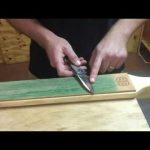Sharpening your tools is an essential part of any DIY project. Whether you’re a professional carpenter or a weekend warrior, having a sharp blade is essential for any job. Whetstone sharpening is a great way to keep your tools in top condition. In this beginner’s guide to whetstone sharpening, we’ll cover the basics of how to use a whetstone, the different types of whetstones, and the best practices for sharpening your tools. With this guide, you’ll be able to keep your tools sharp and ready for any job.
Do you start with 1000 or 6000 whetstone
Sharpening knives is an important part of kitchen maintenance. A whetstone is a great tool for sharpening knives, but it can be difficult to know which one to use. Should you start with a 1000 or 6000 whetstone?
The answer depends on the type of knife you are sharpening. A 1000 grit whetstone is a good choice for dull knives that need a lot of work. It is also a good choice for knives that have been damaged or have chips in the blade. The 1000 grit will remove a lot of material quickly and get the blade back to a sharp edge.
A 6000 grit whetstone is better for knives that are already sharp. It will refine the edge and make it even sharper. It is also a good choice for knives that are made of softer metals, such as stainless steel. The 6000 grit will remove less material and give the blade a finer edge.
When choosing a whetstone, it is important to consider the type of knife you are sharpening. If you are sharpening a dull knife, a 1000 grit whetstone is the best choice. If you are sharpening a knife that is already sharp, a 6000 grit whetstone is the better option. Both will give you a sharp edge, but the 1000 grit will remove more material and the 6000 grit will give you a finer edge.
No matter which whetstone you choose, it is important to use it correctly. Always use a lubricant, such as water or oil, to keep the stone from clogging. Move the blade in a circular motion across the stone, and make sure to keep the blade at the same angle throughout the sharpening process. With a little practice, you can get your knives razor sharp with either a 1000 or 6000 grit whetstone.
What sharpening stone do I start with
Sharpening stones are an essential tool for any knife enthusiast. They come in a variety of shapes, sizes, and grits, so it can be difficult to know which one to start with. Here are some tips to help you choose the right sharpening stone for your needs.
Grits
The grit of a sharpening stone is the measure of its abrasiveness. The lower the grit, the more coarse the stone is, and the higher the grit, the finer the stone is. Generally, a lower grit stone is used for repairing damaged edges, while a higher grit stone is used for honing and polishing. If you are just starting out, a medium grit stone (around 1000-3000) is a good place to start.
Size and Shape
Sharpening stones come in a variety of sizes and shapes. The size of the stone will depend on the size of the blade you are sharpening. A larger stone is better for larger blades, while a smaller stone is better for smaller blades. The shape of the stone is also important. A rectangular stone is best for straight blades, while a round stone is better for curved blades.
Oil or Water
Sharpening stones can be used with either oil or water. Oil stones are usually made of softer materials and are better for honing and polishing. Water stones are usually made of harder materials and are better for repairing damaged edges. If you are just starting out, a water stone is a good choice.
Conclusion
Choosing the right sharpening stone can be a daunting task, but with a little research and knowledge, you can find the perfect stone for your needs. Start with a medium grit stone (around 1000-3000), in a size and shape that is suitable for your blade, and a water stone for repairing damaged edges. With the right sharpening stone, you can keep your knives sharp and in top condition.
Is whetstone sharpening difficult
Sharpening a knife with a whetstone is a skill that requires patience and practice. It is not a difficult task, but it does require some knowledge and technique. Sharpening a knife with a whetstone is a process that involves grinding the blade against the stone to create a sharp edge. The process can be done by hand or with a machine, but it is important to understand the basics of sharpening before attempting it.
The first step in sharpening a knife with a whetstone is to select the right stone. Different stones are used for different types of knives and different levels of sharpness. It is important to select the right stone for the job. Once the stone is selected, it is important to prepare the stone by soaking it in water for at least 10 minutes.
The next step is to place the knife on the stone and begin sharpening. It is important to use a consistent angle and pressure when sharpening. This will ensure that the blade is sharpened evenly. It is also important to move the blade in a circular motion while sharpening. This will help to create a smooth edge.
Once the blade is sharpened, it is important to check the edge for any burrs or nicks. If any are found, they should be removed with a honing steel. This will help to ensure that the blade is sharp and ready for use. Finally, it is important to clean and oil the blade after sharpening.
Sharpening a knife with a whetstone is not a difficult task, but it does require some knowledge and technique. With practice and patience, anyone can learn to sharpen a knife with a whetstone. It is important to select the right stone, use the correct angle and pressure, and check the edge for any burrs or nicks. With the right technique, anyone can learn to sharpen a knife with a whetstone.
Do you push or pull when using a whetstone
Sharpening a blade with a whetstone is a skill that requires practice and patience. Knowing the correct technique is essential for achieving a sharp edge. One of the most common questions is whether to push or pull the blade when using a whetstone.
The answer depends on the type of whetstone you are using. If you are using a double-sided whetstone, you should pull the blade away from you. This will ensure that the blade is evenly sharpened on both sides. If you are using a single-sided whetstone, you should push the blade away from you. This will ensure that the blade is sharpened on one side only.
When using a whetstone, it is important to maintain a consistent angle between the blade and the stone. This will ensure that the blade is sharpened evenly. It is also important to use light pressure when sharpening the blade. Too much pressure can cause the blade to become damaged.
Sharpening a blade with a whetstone is a skill that requires practice and patience. Knowing the correct technique is essential for achieving a sharp edge. Whether you are using a double-sided or single-sided whetstone, it is important to remember to pull the blade away from you when using a double-sided whetstone and push the blade away from you when using a single-sided whetstone. It is also important to maintain a consistent angle between the blade and the stone and to use light pressure when sharpening the blade.
We hope this beginner’s guide to whetstone sharpening has been helpful to you. Remember to take your time and practice patience when sharpening your tools. With a little practice, you’ll be a sharpening pro in no time!
Thank you for reading and goodbye!
















